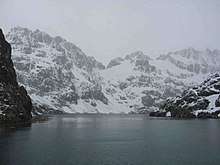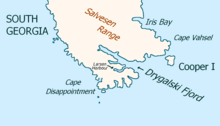Larsen Harbour
Larsen Harbour (Spanish: Bahía Larsen) is a narrow 2.6 miles (4.2 km) long inlet of indenting volcanic rocks and sheeted dykes known as the Larsen Harbour Formation.[1] It is a branch of Drygalski Fjord, entered 2.5 miles (4 km) west-northwest of Nattriss Head, at the southeast end of South Georgia Island. It was charted by the Second German Antarctic Expedition, 1911–12, under Filchner, who named it for Captain Carl Anton Larsen a Norwegian explorer, who made significant contributions to the exploration of Antarctica. The most significant of these was the first discovery of fossils on the continent, for which he received the Back Grant from the Royal Geographical Society.[2] Larsen is also considered the founder of the Antarctic whaling industry and the settlement and whaling station of Grytviken, South Georgia.[3][4][5]


The peaks and mountain crests surrounding the almost land-locked harbour was described by Sir Ernest Shackleton's photographer Frank Hurley as "most beautiful and exceeding all in grandeur even that of Milford Sound".[6]
The Niall Rankin expedition aboard the Albatross, spent some time here as they studied the Weddell seal colony before going on to Esbensen Bay.[7]
The area is rat-free, allowing species such as the South Georgia pipit, and burrowing petrels and prions to thrive. Mountains descend steeply into the sea here, and various glaciers calve into the sea.[8][9]
Named locations
Hash Island lies in the entrance of the harbor. It was roughly surveyed by the German Antarctic Expedition of 1911–12, and probably named by Discovery Investigations personnel who re-surveyed it in 1927.[10]
Williams Cove is a small cove in the north side of Larsen Harbor. The south point of its entrance is called Scoresby Point. Both names were first used on a 1929 British Admiralty chart.[11][12]
Mount Clara and Mount Normann are found inland to the south of Larsen Harbour.
References
- Bell, C.M.; Mair, B.F.; Storey, B.C. "The pre-Cretaceous Larsen Harbour Formation of southern South Georgia" (PDF). British Antarctic Survey. Archived from the original (PDF) on 26 July 2011. Retrieved 25 October 2009. Cite journal requires
|journal=(help) - Rabassa, Jorge; Borla, Maria Laura (21 November 2006). Antarctic Peninsula & Tierra del Fuego. Taylor and Francis. p. 40. ISBN 978-0-415-41379-4.
- Mills, William James (2003). Exploring Polar Frontiers A Historical Encyclopedia. ABC-CLIO. pp. 373–374. ISBN 1-57607-422-6.
- Dr Bernard Stonehouse, ed. (2002). Encyclopedia of Antarctica and the Southern Oceans. Toronto: Wiley. ISBN 0-471-98665-8. Retrieved 25 October 2009.
- "Larsen Harbor". Geographic Names Information System. United States Geological Survey. Retrieved 4 March 2020.
- Murphy, Shane (2001). Shackleton's photographer [CD Rom] : Photographs of scenes and diary of incidents in connection with happenings to the Weddell Sea Party, 12th October, 1914 - 16th October, 1917. Scottsdale, AZ: Shane Murphy. ISBN 0-9703148-2-5. Retrieved 25 October 2009.
- Headland, Robert (1984). The Island of South Georgia. New York: Cambridge University Press. ISBN 0-521-25274-1. Retrieved 25 October 2009.
- Wheeler, Tony (2004). The Falklands & South Georgia Island. Footscray, Vic.: Lonely Planet Publications. p. 160. ISBN 1-74059-643-9. Retrieved 25 October 2009.
- Mair, B. F. "The Larsen Harbour Formation and associated intrusive rocks of southern South Georgia". Bulletin - British Antarctic Survey. British Antarctic Survey, Natural Environment Research Council, Cambridge. 52 (983): 87–107. ISSN 0007-0262.
- "Hash Island". Geographic Names Information System. United States Geological Survey. Retrieved 4 March 2020.
- "Scoresby Point". Geographic Names Information System. United States Geological Survey. Retrieved 4 March 2020.
- "Williams Cove". Geographic Names Information System. United States Geological Survey. Retrieved 4 March 2020.
Further reading
- Carr, Tim; Carr, Pauline (1998). Antarctic oasis : Under the spell of South Georgia. New York: W.W. Norton. ISBN 0-393-04605-2. Retrieved 25 October 2009.
![]()